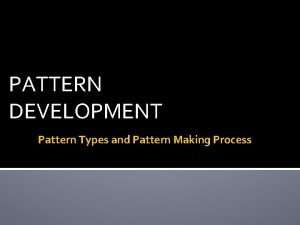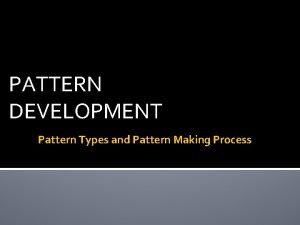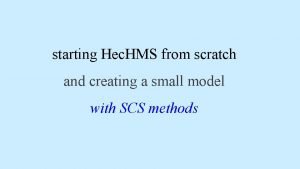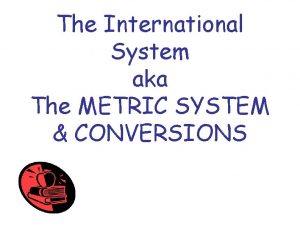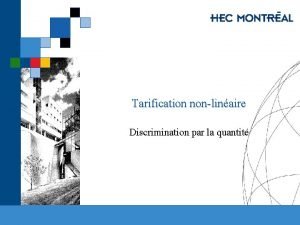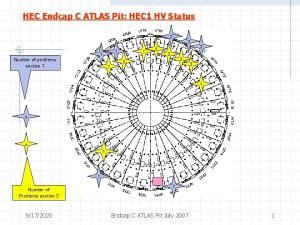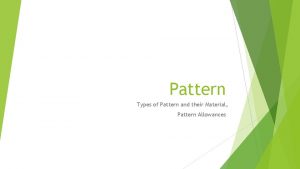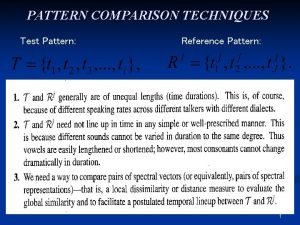PATTERN DEVELOPMENT HEC 703 Lecture 78 Pattern Types
































- Slides: 32

PATTERN DEVELOPMENT HEC 703 Lecture 7&8 Pattern Types and Pattern Making Process

Key Concepts and Terms � Apparel Design folio � Block Pattern � CAD-Computer Aided Design � Costing � Design Details � Design Samples � Drafting a Pattern � Flat Pattern � Garment Cost Sheet � Grading

Key Concepts and Terms � Pattern Specification Sheet � Production Samples � Prototype � Retail � Reverse Engineered Pattern � Sloper Pattern

Pattern Making Process • • Create a pattern for a garment or an apparel product. Consider the design details. Select the materials (fabrication and trims) Construct the sample (prototype) Fit, revise and finalize the sample Create an apparel technical design pack Prepare pattern for individual production

Creating a Pattern � Designers begin by creating a 2 D or 3 D pattern, utilizing one or more of the pattern making methods: � Flat � Drafting � Reversed Engineered � Draping � Computer Generated

Types of 2 D Pattern Making Methods � Flat Pattern- A pattern is created by using an existing foundation pattern known as a sloper or a block. � Sloper (Home Sewing Industry term) or Block (Apparel Manufacturing Industry term) - custom fitted basic pattern based on individual or companies standard size measurements from which other patterns can be made.

Types of 2 D Pattern Making Methods � Drafting a Pattern- Patterns are created by using measurements of an existing garment, an individual, or body form. Pattern is then drawn on paper utilizing the body measurements. � Reverse Engineering a Pattern- Patterns are created by deconstructing an existing garment. It is taken apart, analyzed, and new pattern pieces are created.

Types of 3 D Pattern Making Methods � Draping- A garment is created by molding, cutting, and pinning fabric on an individual or a dress form. It is the oldest method of pattern making. � Computer Generated Patterns- Computer-aided design (CAD) software is used to produce patterns for textiles, apparel and other products. Image Source: www. lucianagrimaldi. com

Consider Design Details Dress Styles: � Shift, A-line, Lower waistline � Princess, Shirtwaist, Coatdress, Asymmetrical, Jumper or Sundress � Neckline Styles: Décolleté (low cut) , Jewel, Boat, Scoop, Horseshoe, Cowl, Square, V, Off the Shoulder, Sweetheart, and Keyhole. � Shirt Styles: Dress, Sport, Polo, Western, T -shirt, Tank, Fitted, Tunic, Camisole � Collar Styles: Shirt, Button , Sailor, Convertible, Peter Pan, Mandarin, Band, Turtleneck, Shawl, Bow Tie, � Sleeve Types: Set-in, Kimono, Raglan � Set-In Sleeves Types: Bishop, Bell, Lantern, Cape, Shirt, Puff, Cowl, , Roll-up, Leg-o. Mutton, Shirred, and Two-Piece Tailored

Consider Design Details � Kimono Sleeve With Gusset, Dolman, � Raglan Sleeve Types � Skirt Styles: Straight, A -line, Flared, Circular, Full, Pleated, Gathered, Dirndl, Gored, Wrap � Pant Styles: Tapered, Straight, Flared, Jean, Palazzo, Harem, Bermuda � Shorts, and Shorts, � Culottes � Jacket Styles: Trench, Blazer, Fitted, Tuxedo, Cardigan, Poncho, Cape, Safari, Windbreaker, Bolero, and Box � Pockets- Patch, Inseam, Welt, Flap

Selecting The Materials and Costing � Once a design is created and the pattern is engineered, the materials (fabrication and trims) are sourced. (Consider wholesale vs. retail when sourcing materials. ) � Preliminary costing is completed to insure profitability. � Costing Considerations- fabrics, trims, design details, and labor costs.

Construct the Sample � Sample garments (prototypes) are created by sample makers. � Sample makers must be skilled in a variety of sewing construction techniques. � Ensure fit and design integrity. � Fashion fabric is used to create a sample garment.

FIT, REVISE, AND FINALIZE THE PATTERN � Use a mannequin or a live model to check the fit and styling of the sample garment. � Revise garment fit until it is correct. Photo Source: gardnerstreetvintage. tumblr. com

Apparel Design Folio � The Apparel Design Folio are created after the final designs are developed � The folio contains specific information about the design and should include the following: 1. Detailed flat sketch with front and back views. Should include topstitching, pocket and button placement, placement of contrast fabrications, hem and band widths, etc.

Apparel Design Folio cont. � 2. Directions for any special fabric direction or matching. For example borders, napped fabric etc. � 3. Any special seam allowances, decorative or standard topstitching, stitch length, thread type and color. � 4. Include samples of fabrics and trims. Clearly indicate what is Self, Contrast, Trim, and Lining fabrics. � 5. Measurement details. � 6. Care Instructions for labeling � 7. Color details and season information

DESIGNING AND SAMPLING USING COMPUTERS �Computers can be used to pass detailed design information to machinery quickly so that samples can be made during the design and development stages. �A design process that previously took weeks or months can now take less than 24 hrs to present ideas

Focus: The ways in which textile products are manufactured in industry. Relate this to home-made /custom made garments

Design development and presentation at industry level Computer-integrated manufacturing (CIM) systems integrate or link CAD and CAM systems. These combined systems link design development, production planning and manufacturing systems together. Companies that use CIM are able to design a product in one country and manufacture it overseas where labour costs are lower.

The production systems and their processes There are three main types of production system. �One-off production is designing and making a single textile product to a client's specification. The garment design is developed from a basic block pattern, with a prototype made from inexpensive fabric to test the drape, fit and assembly of the garment

Cont. Batch production is manufacturing set quantities of a textile product to order. �The prototype is made up in a medium size from the intended fabric. �The prototype is checked for quality of design and manufacture, then put into production in a range of standard sizes. Mass production is industrial-scale manufacture of large quantities of products, usually on a production line.

Lay planning and costing �Lay-planning is the laying out of pattern pieces of a fabric to work out the quantity and cost of material required for a product. �Costing is working out how much each product costs in terms of including materials, labour, rent and energy costs.

Sample of an Apparel Design Folio Season. Style #Body Measurements Hardware and Trim Fabrication and Color Swatch of Fabrics Date. Designer. Technical Sketch - include design and construction details Care Label Information Comments

Prepare Pattern For Mass Production � Once a sample pattern has been approved for size, costing, availability of materials, and potential profit; it is used for production samples and samples for sales promotion. � The approved pattern is graded into smaller and larger sizes usually by computer but can be done by hand. � Final fabric selections and trims are ordered by suppliers.

Pattern Grading � Grading a pattern is a way of sizing a pattern up (or down) while maintaining the proportions of the original pattern/ or. Pattern grading is the process of creating a range of sizes for a single style. � The "grade rules" refer to the amount of change between sizes, for each measurement point. For example, the bust, waist and hip "grade" 1" between sizes for most of the Misses size range. �.


� If you started with a size 8 dress and needed to make another one in a size 10, you'd make the bust, waist and hip 1" larger. You'd do this primarily by making the adjustment at the side seam, and distribute the 1" size difference evenly at each seam


Production Plan Production planning � Production plans and work schedules are important planning � The production plan should set out information about all the stages of production, so that every product is made to the same quality. See example below:

Each production plan should include the following stages: � The preparation stage details the amount of materials to buy-in, preparation of garment patterns, templates and lay plans. � The processing stage details the fabric spreading, cutting, labelling and bundling of the fabric pieces. � The assembly stage contains instructions for fusing, joining and pressing the separate product parts. � The finishing stage gives instructions for decorative/functional finishing and final pressing. � The packaging stage explains how to label, hang, fold, and cover the product ready for transport to the retailer.

Work schedule A work schedule sets out instructions about the order of assembly, the stitch type, the processes to be used, the time each process will take and the seam allowance. See the example of a work schedule below:

Work schedule below for a skirt Order of assembl y Stitch type 1 Process time in minutes Seam allowance Lockstitch Stitch pockets 2. 00 1. 00 cm 2 Lockstitch Stitch pockets to front 2. 00 1. 00 cm 3 Overlock Join back seam 1. 00 cm 4 Lockstitch Insert zip 2. 00 0. 20 cm 5 Overlock 1. 50 1. 00 cm 6 Lockstitch Join waistband 2. 50 to top 0. 60 cm 7 Blind Turn up hemming 1. 50 0. 20 cm N/A 12. 50 N/A Join side seams Total process

tutorial Define � Size Classifications � Flat Pattern� Draping� Haute couture � prêt-á-porter Discuss the production system and the processes involved in the way the following are manufactured in the industry � One-off production � Batch production. Discuss the major roles of a fashion designer �The end
 517 rounded to the nearest ten
517 rounded to the nearest ten Hcrw management
Hcrw management 111 binary to decimal
111 binary to decimal Ucc 2-313
Ucc 2-313 Kar 5
Kar 5 01:640:244 lecture notes - lecture 15: plat, idah, farad
01:640:244 lecture notes - lecture 15: plat, idah, farad Patterns of development in writing narration
Patterns of development in writing narration Radial line development
Radial line development Types of pattern making
Types of pattern making Types of pattern development
Types of pattern development Index flow hec hms
Index flow hec hms Hec-ras software
Hec-ras software Inline structure hec ras
Inline structure hec ras Hec ras reference manual
Hec ras reference manual Hec ras manual
Hec ras manual Hec ras junction
Hec ras junction Hec-ras 1d unsteady compressible flow
Hec-ras 1d unsteady compressible flow Modeling long culverts in hec-ras
Modeling long culverts in hec-ras Steady flow data hec-ras
Steady flow data hec-ras Hec.dz moodle
Hec.dz moodle Km hec dec m dm cm mm
Km hec dec m dm cm mm Hec-ras cross section interpolation
Hec-ras cross section interpolation Moodle hec alger
Moodle hec alger Hec-ras download army corps
Hec-ras download army corps Laurent simon hec
Laurent simon hec Hec montreal tarif
Hec montreal tarif Steady vs unsteady flow hec-ras
Steady vs unsteady flow hec-ras Aone cours
Aone cours Lateral structure hec ras
Lateral structure hec ras Hec-fda
Hec-fda Des hec
Des hec Hec ressim
Hec ressim Hec-2 download
Hec-2 download








